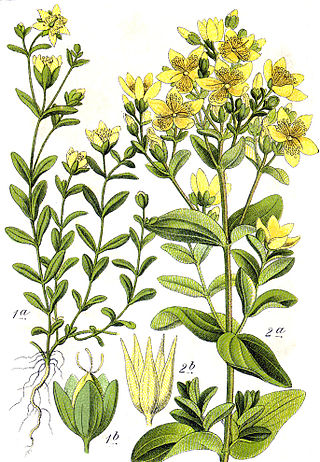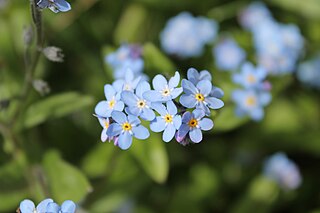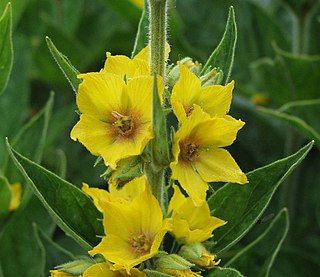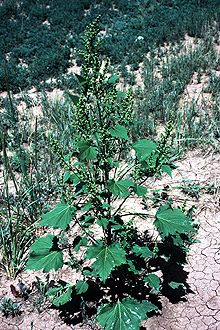
Hypericum tetrapterum is a herbaceous perennial plant species in the flowering plant family Hypericaceae. Its common names include St. Peter's wort, Peterwort, square stemmed St. John's wort, and square stalked St. John's wort.

Silene dioica, known as red campion and red catchfly, is a herbaceous flowering plant in the family Caryophyllaceae, native throughout central, western and northern Europe, and locally in southern Europe. It has been introduced in Iceland, Canada, the US, and Argentina.

Draba aizoides is a species of flowering plant in the family Brassicaceae, known as yellow whitlow-grass. It is native to Europe where it is found on limestone rocks and walls. In the British Isles it is found only on the Gower Peninsula in Wales.

Myosotis sylvatica, the wood forget-me-not or woodland forget-me-not, is a species of flowering plant in the family Boraginaceae, native to Europe. This spring-flowering plant and its cultivars, typically with blue flowers, are the familiar forget-me-nots of gardens.

Veronica arvensis, common names: wall speedwell, corn speedwell, common speedwell, rock speedwell, field speedwell, is an annual flowering plant in the plantain family Plantaginaceae. The species is native to Europe and a common weed in gardens, pastures, waste places, and cultivated land.

Large bindweed, Calystegia silvatica, is the largest species of bindweed and is a strong rampant climber. It is native to southern Europe but has been introduced to many other areas because it is an attractive garden plant. Calystegia silvatica subsp. fraterniflora(Mack. & Bush) Brummitt is native to North America.

Cerastium glomeratum is a species of flowering plant in the family Caryophyllaceae known by the common names sticky mouse-ear chickweed and clammy chickweed. It is native to Europe, Macaronesia to Assam but is known on most continents as an introduced species. It grows in many types of habitat. The blooming period is February, March, April, and May.

Vicia sylvatica, known as wood vetch, is a species of flowering plant in the bean family Fabaceae. It was described by Carl Linnaeus.

Trifolium hybridum, the alsike clover, is a species of flowering plant in the pea family Fabaceae. The stalked, pale pink or whitish flower head grows from the leaf axils, and the trifoliate leaves are unmarked. The plant is up to 40 centimetres (1.3 ft) tall, and is found in fields and on roadsides – it is also grown as fodder. The plant blooms from spring to autumn. Originating in mainland Europe, it has become established as an introduced plant in the British Isles and throughout the temperate regions of the world.

Epilobium hirsutum is a flowering plant belonging to the willowherb genus Epilobium in the family Onagraceae. It is commonly known as the great willowherb, great hairy willowherb or hairy willowherb. Local names include codlins-and-cream, apple-pie and cherry-pie.

Symphytum officinale is a perennial flowering plant in the family Boraginaceae. Along with thirty four other species of Symphytum, it is known as comfrey. To differentiate it from other members of the genus Symphytum, this species is known as common comfrey or true comfrey. Other English names include boneset, knitbone, consound, and slippery-root. It is native to Europe, growing in damp, grassy places. It is locally frequent throughout Ireland and Britain on river banks and ditches. It occurs elsewhere, including North America, as an introduced species and sometimes a weed. The flowers are mostly visited by bumblebees. Internal or long-term topical use of comfrey is discouraged due to its strong potential to cause liver toxicity.

Succisa pratensis, also known as devil's-bit or devil's-bit scabious, is a flowering plant in the honeysuckle family Caprifoliaceae. It differs from other similar species in that it has four-lobed flowers, whereas small scabious and field scabious have five lobes and hence it has been placed in a separate genus in the same family. It also grows on damper ground.

Lysimachia punctata, the dotted loosestrife, large yellow loosestrife, circle flower, or spotted loosestrife, is a flowering plant species in the family Primulaceae.

Lysimachia foemina is commonly known as blue pimpernel or poor man's weatherglass, and was formerly called Anagallis foemina. It is a low-growing annual herbaceous plant in the genus Lysimachia of the family Primulaceae. In a comparison of DNA sequences, L. foemina was shown to be most closely related to L. monelli. It had been thought by many to be closest to L. arvensis, and some authors had even included L. foemina as a subspecies of L. arvensis, as Anagallis arvensis subsp foemina. These three species were among several transferred from Anagallis to Lysimachia in a 2009 paper.

Papaver dubium is a species of poppy known by the common names long-headed poppy and blindeyes. It is an annual species which prefers sandy soils without lime. It is native to Europe, North Africa and south-western Asia and widespread as an introduction in America and elsewhere.

Cyclachaena xanthiifolia, known as giant sumpweed, or rag sumpweed is a North American plant species in the sunflower family, Asteraceae. It is the only species in the genus Cyclachaena. Giant sumpweed is believed to be native to the Great Plains but is now found across much of southern Canada and the contiguous United States, though rarely in the Southeast.

Silene uniflora is a species of flowering plant in the family Caryophyllaceae known by the common name sea campion.
Fumaria occidentalis, the western ramping-fumitory, is a species of flowering plant in the genus Fumaria that is endemic to Cornwall. It is the largest of the British fumitories, and was discovered in 1904.

Carex pulicaris, the flea sedge, is a species of sedge in the genus Carex native to Europe.

Orobanche hederae, the ivy broomrape, is, like other members of the genus Orobanche, a parasitic plant without chlorophyll, and thus totally dependent on its host, which is ivy. It grows to 60 cm (2 ft), with stems in shades of brown and purple, sometimes yellow. The flowers are 10–22 mm (0.4–0.9 in) long, cream in colour with reddish-purple veins.




























